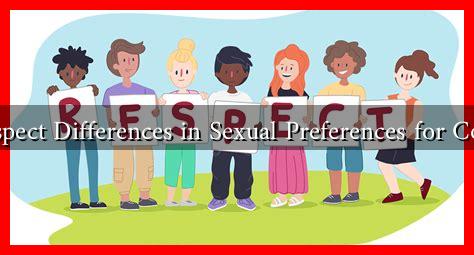-
Table of Contents
How to Respect Differences in Sexual Preferences for Compatibility
In today’s diverse society, understanding and respecting differences in sexual preferences is crucial for fostering healthy relationships. Compatibility in sexual preferences can significantly impact the dynamics of a relationship, influencing emotional intimacy, communication, and overall satisfaction. This article explores how to navigate these differences respectfully, ensuring that both partners feel valued and understood.
Understanding Sexual Preferences
Sexual preferences encompass a wide range of behaviors, desires, and orientations. They can include preferences for certain sexual activities, the frequency of sexual encounters, and even the types of relationships individuals seek (monogamous, polyamorous, etc.). Recognizing that these preferences are deeply personal and can vary greatly from one individual to another is the first step toward fostering compatibility.
The Importance of Open Communication
Effective communication is the cornerstone of any successful relationship, especially when it comes to discussing sexual preferences. Here are some strategies to enhance communication:
- Establish a Safe Space: Create an environment where both partners feel comfortable expressing their thoughts and feelings without fear of judgment.
- Use “I” Statements: Frame discussions around personal feelings and experiences to avoid sounding accusatory. For example, say “I feel…” instead of “You make me feel…”.
- Be Honest and Direct: Clearly articulate your preferences and desires while being open to hearing your partner’s perspective.
According to a study published in the Journal of Personal and Social Relationships, couples who engage in open discussions about their sexual preferences report higher levels of relationship satisfaction and intimacy.
Respecting Differences
Respecting differences in sexual preferences is essential for maintaining a healthy relationship. Here are some ways to show respect:
- Acknowledge Individuality: Recognize that each person has unique experiences and preferences shaped by their background, culture, and personal history.
- Practice Empathy: Try to understand your partner’s perspective and feelings regarding their sexual preferences. This can help bridge gaps in understanding.
- Avoid Pressure: Never coerce or pressure your partner into engaging in sexual activities they are uncomfortable with. Consent is paramount.
For instance, consider a couple where one partner enjoys BDSM while the other prefers more traditional sexual practices. Instead of dismissing the BDSM partner’s interests, the couple can explore ways to incorporate elements of both preferences, fostering a sense of compromise and respect.
Finding Common Ground
While differences in sexual preferences can pose challenges, they can also present opportunities for growth and exploration. Here are some tips for finding common ground:
- Explore New Experiences Together: Be open to trying new things that may appeal to both partners. This can lead to discovering shared interests.
- Set Boundaries: Establish clear boundaries that respect both partners’ comfort levels while allowing for exploration.
- Seek Professional Guidance: If differences become a significant source of conflict, consider consulting a therapist or sexologist who specializes in sexual compatibility.
Research indicates that couples who actively seek to understand and accommodate each other’s sexual preferences are more likely to maintain long-term satisfaction in their relationships. A study from the American Psychological Association found that couples who engage in mutual exploration report higher levels of intimacy and connection.
Conclusion
Respecting differences in sexual preferences is vital for compatibility and relationship satisfaction. By fostering open communication, practicing empathy, and finding common ground, couples can navigate their differences in a way that strengthens their bond. Remember, every relationship is unique, and embracing these differences can lead to deeper intimacy and understanding. Ultimately, the key takeaway is that respect and open dialogue are essential in creating a fulfilling and harmonious relationship.

